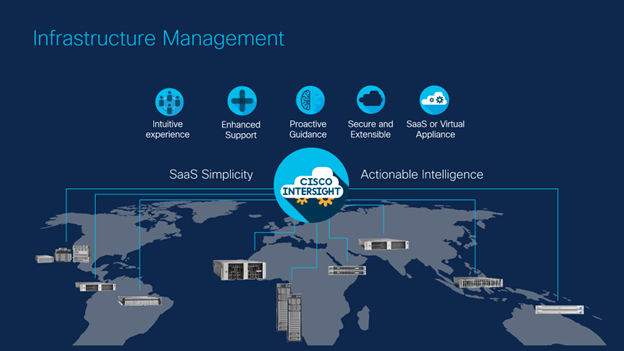and management for the requirements of modern data centers and hybrid clouds
In my previous blog, I wrote extensively about the modular, programmable, and future-ready design and architecture of the Cisco UCS X-Series that is redefining data center and hybrid cloud computing. One of the key attributes of the X-Series is its industry-leading capabilities in efficient energy usage and cooling.
In this blog, I will focus on Cisco Intersight and its many innovations that derived directly from customer requirements to successfully implement their own hybrid cloud operating model. There are three key aspects of Intersight that I’ll dive into: core management simplicity, simplified operations, and workload management beyond data centers.
Core Management Simplicity
Organization is a key attribute of simplicity. For Intersight, this begins with the ability for users to tier the criticality of infrastructure so that they can optimize their data center designs. Intersight improves upon legacy models that often have no relation of criticality, which implies that all nodes are assumed to need highest availability support often at the highest-tier service levels. Intersight can manage the criticality as a policy, and in concert with the X-Series, can scale up or down services based on DC events (e.g., PDU or DC-feed brown outs).
Intelligence and analytics are essential to Intersight’s effectiveness, such as integrated workload analytics to offer users specific recommended optimizations. Intersight offers a framework that can analyze the data from deep within the infrastructure (e.g., with a solution like X-Series) the users have a simpler method to right-size hardware.
Ability to scale up infrastructure is a requirement all customers need and something Intersight enables. But just as importantly, Intersight enables customers to scale down infrastructure, which is often left undisturbed even if there are opportunities to optimize. With stateless infrastructure, Intersight enables rapid scale in a relatively short time period. Intersight then can use the same elements to return those nodes to other uses or power down. Of course, as business needs change, customers can restart those same nodes with all the same characteristics.
Simplified Operations
We know that customers are moving their workloads between their data centers and clouds regularly. In fact, according to the Hybrid Cloud Trend Report from The451, 53 percent of customers they surveyed said that they are moving workloads between on-premises and public cloud environments weekly. Intersight can greatly simplify this with Dynamic Workload Mobility, which allows defined workloads at the bare-metal layer to be moved between locations. In addition to operational simplicity, Intersight can help customers measure metrics such as Power Usage Effectiveness (PUE) earlier in the orchestration process for optimizing energy efficiency.
Intersight can also deliver simplicity with easier methods for lifecycle operations within an infrastructure. Specifically, Intersight enables stateless and intent-based deployments that can allow faster mean-time-to-resolution (MTTR) for individual elements and offer a model of leaving elements requiring maintenance to be handled in hours during routine events. This has the effect of reducing off hour operations which consume power in offices and data centers alike.
Additionally, Intersight can extend Information Lifecycle Management (ILM) concepts to the world of compute. As newer components of servers are available (e.g., CPU, DRAM) those can take on the server instance previously deployed on a previous generation item. In most cases the system continues to operate just with more capability – saving time in re-deploying completely new groups of infrastructure. And with modularity and disaggregated components, customers are able to change out computing elements more “atomically” and can potentially also help scale down unnecessarily overprovisioned infrastructure without rebuilding.
Extending workloads beyond the core data center
Intersight offers the same model whether the customer site is within a core data center, at a colocation facility, aggregation side, edge, etc. Customers we have talked with envision using the UCS X-Series with Intersight to provide the business access to a variety of workload options including bare metal, containers, standard virtual server hosting, and many others.
Customers will often have segmented teams that handle the full stack between these locations, and with Intersight and UCS it is possible to make those team focus segments more of a logical instance over common hardware. Benefits of this approach include:
- Spreading the work-per-watt to more sites with standardized and lower impact power and cooling that a DC.
- Simplifying sparing of the stateless hardware elements between more sites.
- Improving energy efficiency and lowering power demands at core data center locations.
Get started today
We encourage existing and new customers to see the power of Intersight for themselves by requesting a 1-on-1 demo with one of our experts. Also, I’ll be hosting a #CiscoChat on Thursday Nov. 3 with an expert panel to discuss various topics related to computing design and data center/hybrid cloud operations.
Please join me and a panel of experts for our next
#CiscoChat
Thursday 11/3/2022

#Cisco Chat